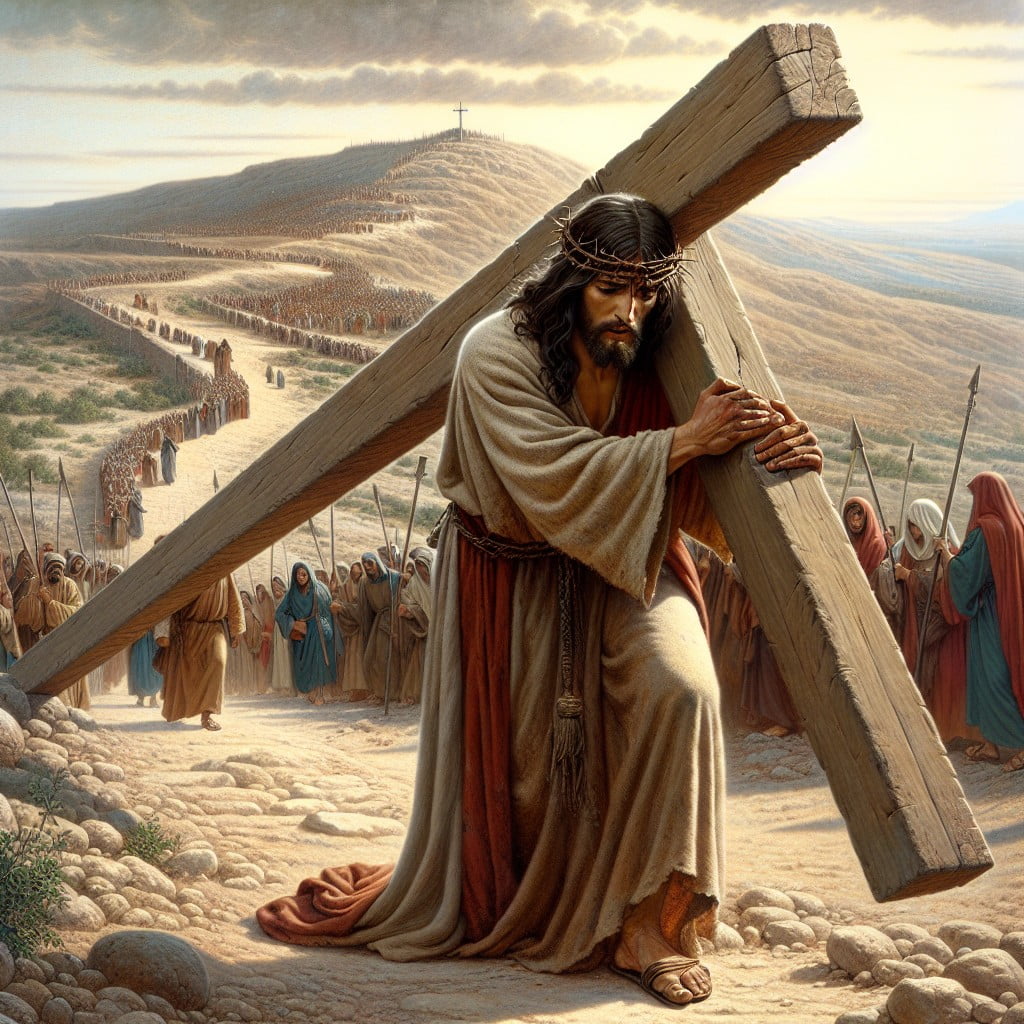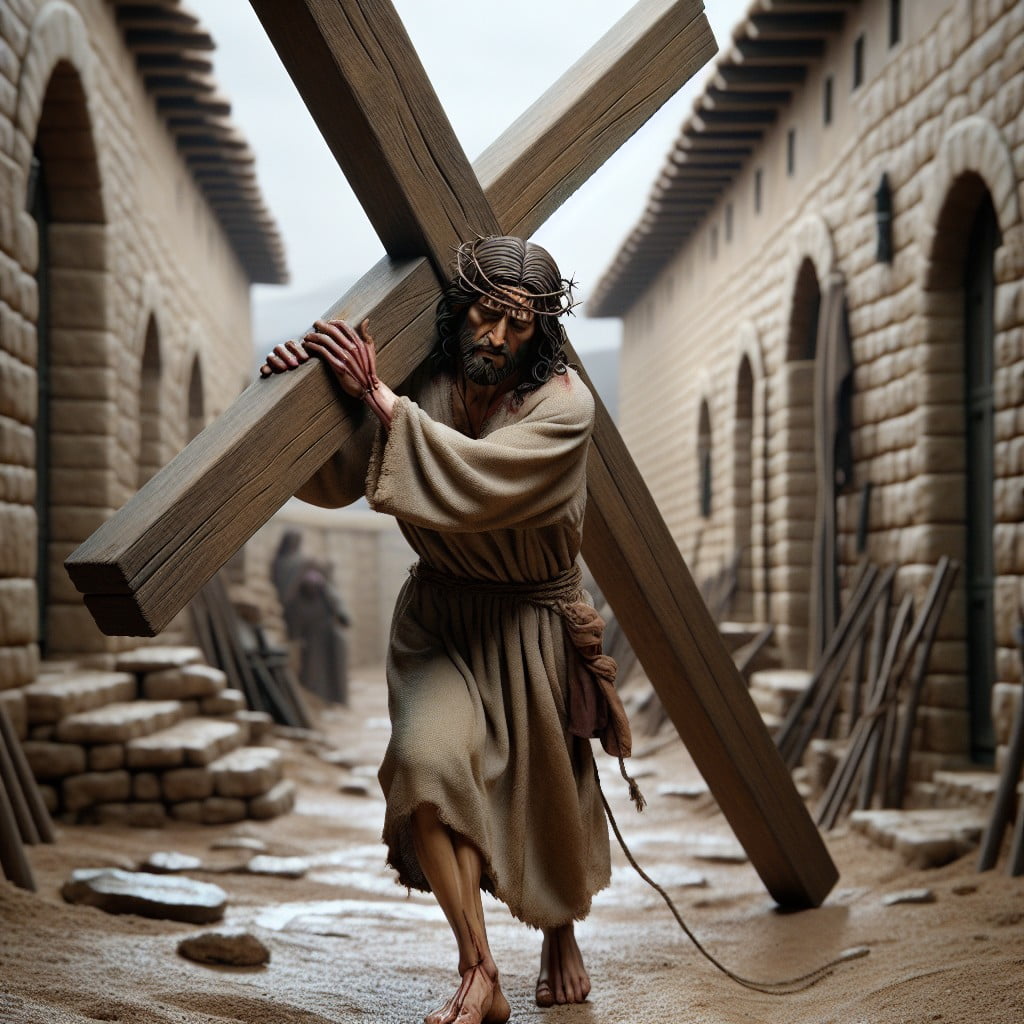Exploring the distance Jesus carried the cross reveals intriguing historical insights because each step he took embodies a profound spiritual significance.
Key takeaways:
- Jesus may not have carried the cross for the entire distance.
- The exact distance Jesus carried the cross is uncertain.
- Jesus endured physical and emotional hardships before the journey.
- The duration of carrying the cross was estimated to be 30 minutes to an hour.
- Carrying the cross symbolizes sacrifice, redemption, and the Christian journey.
Overview of the Canonical Gospels That Mention Jesus Carrying the Cross

The event of Jesus carrying the cross is mentioned in all four canonical gospels—Matthew, Mark, Luke, and John. Each account provides details that contribute to our understanding of the event:
- Matthew (27:31-32) implies Jesus began the journey bearing his own cross until Simon of Cyrene was compelled to carry it for him.
- Mark (15:20-21) mirrors Matthew’s account with a similar sequence of events, introducing Simon of Cyrene as the person who aided Jesus.
- Luke (23:26) directly states that Simon was seized from the crowd to bear the cross behind Jesus, suggesting Jesus may not have carried the cross for the entire distance.
- John (19:17) describes Jesus going out to the place of the Skull, carrying his cross, with no mention of Simon, highlighting Jesus’ sole burden of the cross’s weight.
These accounts shape a composite picture of the journey to Golgotha, reflecting the physical and spiritual weight of the experience.
Analysis of Luke 23:26 and John 19:17 to Understand the Distance Jesus Carried the Cross

The gospel of Luke states, “As they led him away, they seized Simon from Cyrene, who was on his way in from the country, and put the cross on him and made him carry it behind Jesus.” This passage suggests that Simon was compelled to assist at some point during the journey to Golgotha.
In John’s account, the wording is slightly different: “Carrying his own cross, he went out to the place of the Skull (which in Aramaic is called Golgotha).” It implies Jesus started the journey bearing the cross.
These scriptural references highlight two main points:
- 1. Assistance of Simon: Jesus may not have carried the cross the entire distance due to physical exhaustion, suggesting the distance carried by Jesus alone may be less than the full path to Golgotha.
- 2. Point of transition: The exact location where Simon took over is not specified, making it difficult to ascertain the precise distance Jesus carried the cross.
Scholars infer the route, known as the Via Dolorosa, as approximately 600 meters, from the former Antonia Fortress to the Church of the Holy Sepulchre. Given the lack of explicit distance markers within the texts, this estimate forms through historical context and traditional routes observed in Christian practice.
Exploration of Jesus Christ’s Physical Condition and Endurance
Prior to the arduous journey to Golgotha, Jesus had endured a night of trials, physical beatings, and emotional stress. Such factors would have significantly affected his endurance:
- Scourging: Roman floggings were known to cause severe physical trauma, leading to substantial blood loss and weakening a person’s overall state.
- Sleep Deprivation: The events leading up to the crucifixion followed a night without rest, contributing to fatigue.
- Psychological Stress: Anticipating the suffering and the burden of the crucifixion would likely have exacerbated his exhaustion.
- Carrying the Crossbeam: Typically, the condemned were required to carry only the horizontal beam (patibulum) that could weigh around 30 to 40 pounds, rather than the entire cross.
The combination of these factors would have made the journey particularly grueling, highlighting both the physical and spiritual aspects of Jesus’s suffering.
Duration of Carrying the Cross
It’s estimated that Jesus’s journey to the crucifixion site took about 30 minutes to an hour. This timeframe considers factors such as:
- The physical state of Jesus after being scourged.
- The pace at which Roman soldiers typically forced prisoners to move.
- The topography and distance of the path known as Via Dolorosa.
However, extra-biblical sources and traditional Stations of the Cross (a series of images depicting Jesus on his way to being crucified) suggest it could have been a prolonged and arduous walk due to multiple falls and pauses for rest.
The process was grueling and designed to be a public spectacle, intended as much for punishment and humiliation as it was for the actual execution. Thus, while the physical journey may have spanned a relatively short distance, the duration and intensity of carrying the cross made it a central aspect of the passion narrative.
Understanding this provides valuable insight into the severity of the trial Jesus underwent before reaching Golgotha, which is considered to be one of the most profound demonstrations of endurance in the face of suffering.
What Is the Significance of Jesus Carrying the Cross?
Jesus’ journey with the cross is laden with theological importance, symbolizing his willing sacrifice for humanity’s sins. This act of carrying his own means of execution illustrates the depth of his suffering and humility, embodying the Christian belief in redemptive suffering. It also serves as a profound display of his human vulnerability, bridging the divine with the earthly experience of pain and burden.
In Christian doctrine, the episode is a testament to obedience, with Jesus accepting his fate in accordance to divine will, an ultimate act of submission to the Father. This event sets a template for believers, suggesting that personal crosses must be borne with faith and fortitude.
Moreover, the act of carrying the cross has come to represent the Christian journey itself—the path of discipleship, encompassing trials, perseverance, and the continuous pursuit of spiritual growth. It invites reflection on themes of forgiveness, redemption, and the transformative power of love.
How Far Did Simon of Cyrene Carry Jesus’ Cross?
In the narrative of Jesus’ crucifixion, Simon of Cyrene is compelled by the Roman soldiers to take up the cross, aiding Jesus due to His weakening physical state. Biblical scholars suggest this occurred shortly after the journey began, as the weight of the cross and the prior physical torment became overwhelming for Jesus.
Here are a few key points about Simon’s role:
- Simon’s assistance is mentioned in the Synoptic Gospels of Matthew, Mark, and Luke, signifying its importance in the narrative.
- Cyrene, Simon’s place of origin, is located in modern-day Libya, indicating the presence of diverse regions and populace in ancient Jerusalem.
- The actual distance Simon helped carry the cross is not definitively mentioned in the scriptures. However, the Via Dolorosa, the traditional path believed to be walked by Jesus, stretches approximately 600 meters within the Old City of Jerusalem. Simon would have assisted for a portion, if not the remainder, of this route.
- By carrying the cross, Simon is often seen as representing humanity’s shared responsibility and following Christ’s path of suffering.
- Though not extensive, Simon’s contribution is a profound testament to the weight of sacrifice, indicative of the immense physical and spiritual burden carried by Jesus.
Understanding Simon’s short journey sharing the load of the cross deepens the reflection on empathy, aid, and how burdens might be lightened through collective support.
How Many Times Did Christ Fall Carrying the Cross?
Christian tradition speaks of three falls during the journey to Calvary, symbolizing Jesus’ humanity and the immense burden he bore. These falls are not explicitly documented in the canonical Gospels but are commemorated in the Stations of the Cross, primarily a Catholic devotional practice:
1. The First Fall is commemorated as the Third Station of the Cross, representing the weight of the sins of humanity.
2. The Second Fall, the Seventh Station, speaks to the struggle and determination in Jesus’ journey.
3. The Third Fall, the Ninth Station, signifies near exhaustion yet embodies the resilience to fulfill his purpose.
These moments are keystones in the narrative of passion plays and have deeply influenced Christian iconography and meditation practices.
Historical and Biblical Background
In ancient Judea, under Roman rule, crucifixion was a common form of execution for rebels and criminals. It was designed to be a public spectacle, dissuading onlookers from dissent. The condemned were typically forced to carry their cross or at least the horizontal beam (patibulum) to the place of execution, adding to their humiliation and suffering.
The gospels differ slightly in their accounts of the event, but they agree on the essential details. The journey to Golgotha, the ‘place of the skull’, is where Jesus was crucified. This path is now commemorated by the Via Dolorosa in Jerusalem, which translates to ‘Way of Suffering’. While the exact route is debated, tradition holds it as the path Jesus walked, burdened by the cross.
Understanding this historical context enriches the gravity of the narrative, showcasing the strenuous physical and psychological ordeal endured. The exact distance of this journey, while not specified in the Bible, is traditionally considered to be about 600 meters (roughly 650 yards), though some estimates suggest it could have been up to half a mile. Each step, weighed down by the cross, was a step towards the fulfillment of prophecy and the cornerstone of Christian faith.
Via Dolorosa
Located within the Old City of Jerusalem, Via Dolorosa, which translates to “Way of Suffering,” is believed to be the path that Jesus walked while bearing the cross to the site of crucifixion. This route holds profound spiritual significance for Christian pilgrims who visit these sacred grounds, eager to reflect upon the Passion of Christ.
The path is marked by fourteen Stations of the Cross, each capturing a moment from Jesus’s final journey—from His condemnation by Pilate to His burial. These stations encourage meditation on the trials and sacrifices of Jesus, providing an opportunity for believers to engage deeply with their faith.
Walking the Via Dolorosa is an intimate pilgrimage, traditionally followed on Fridays, particularly during Lent and most solemnly on Good Friday. Each step along this path offers a moment to contemplate suffering, endurance, and the ultimate expression of unconditional love. As a physical manifestation of the path of sorrows, Via Dolorosa connects the physical reality of historical events with the spiritual journey each Christian can take to foster understanding and empathy for the pain endured by Christ.
The Symbolic Meaning of Carrying the Cross
The act of Jesus carrying the Cross resonates deeply with Christian teachings on sacrifice, redemption, and love. The burden of the Cross embodies the weight of human sin for which Jesus was prepared to suffer. As he trekked towards Calvary, the trials faced along the path exemplified his unwavering dedication to humanity’s salvation.
In spiritual practice, bearing one’s cross has come to symbolize the personal challenges and hardships endured in the pursuit of faith and moral integrity. Christians are encouraged to emulate Christ’s perseverance, understanding that their own struggles serve to fortify their spiritual resolve and foster deeper connection with the Divine.
Moreover, the journey with the Cross illustrates an essential message of hope. Despite the suffering and the falls, the ultimate destination remains one of triumph over adversity through divine grace. This powerful imagery acts as a beacon, guiding adherents through their own tribulations with the assurance of spiritual rebirth and eternal life.